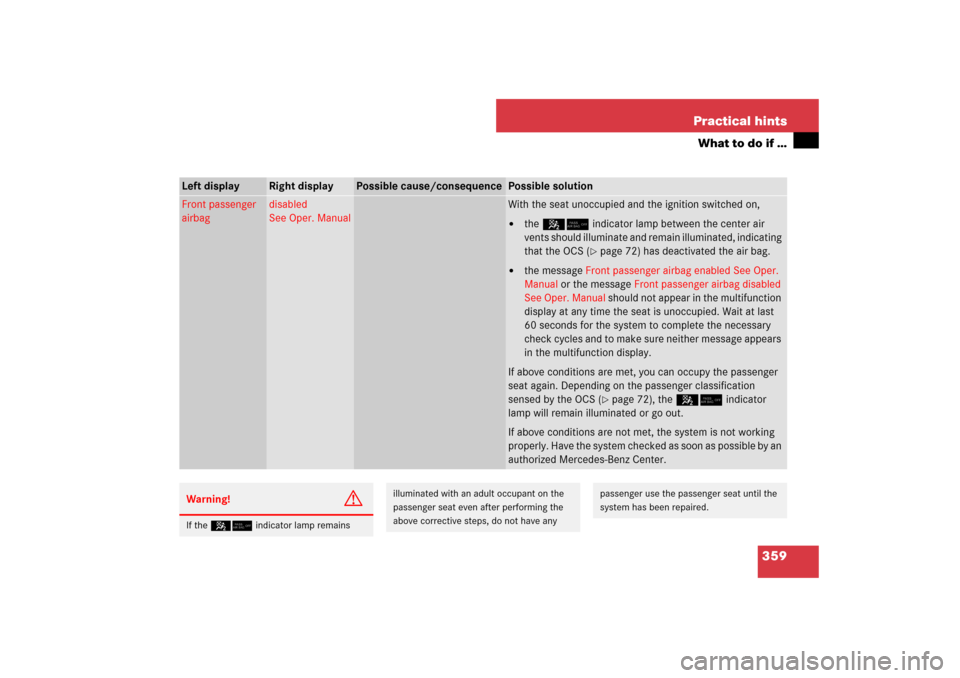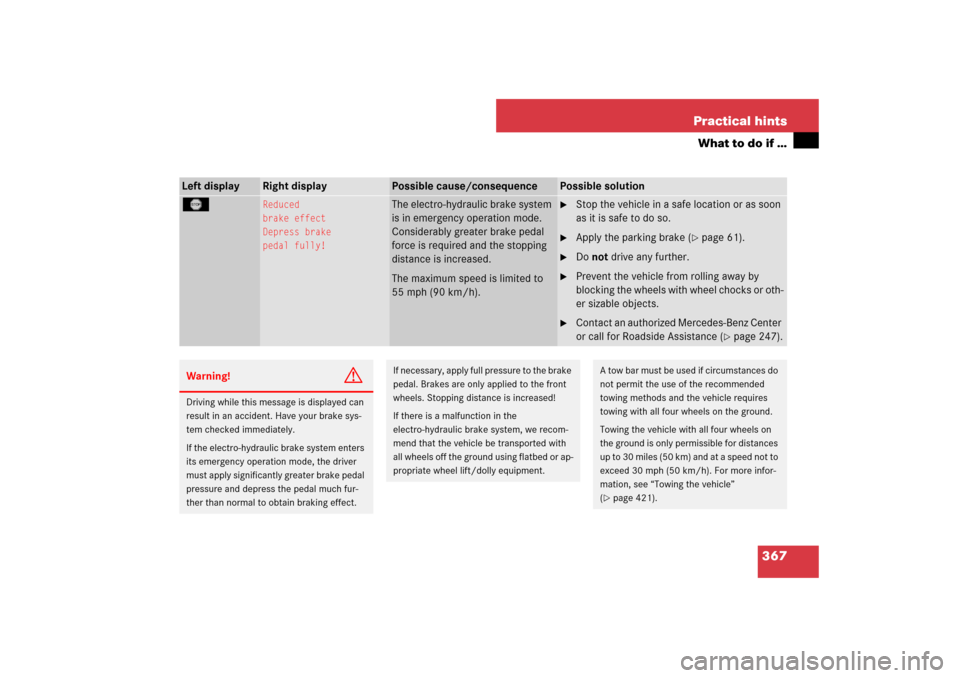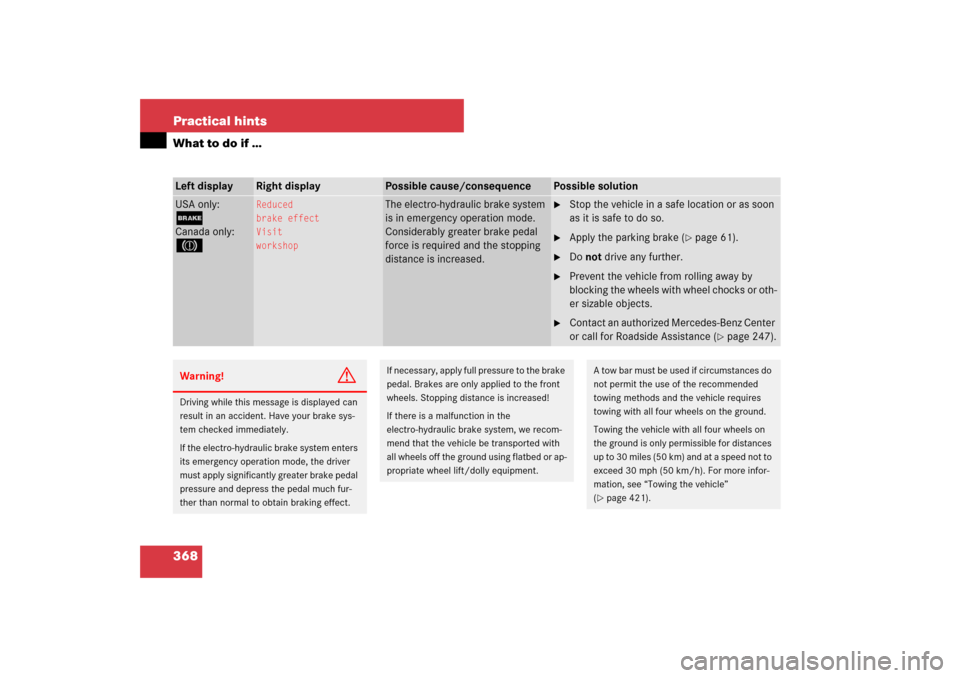Page 360 of 473

359 Practical hints
What to do if …
Left display
Right display
Possible cause/consequence
Possible solution
Front passenger
airbag
disabled
See Oper. Manual
With the seat unoccupied and the ignition switched on,�
the 5/indicator lamp between the center air
vents should illuminate and remain illuminated, indicating
that the OCS (
�page 72) has deactivated the air bag.
�
the message Front passenger airbag enabled See Oper.
Manual or the message Front passenger airbag disabled
See Oper. Manual should not appear in the multifunction
display at any time the seat is unoccupied. Wait at last
60 seconds for the system to complete the necessary
check cycles and to make sure neither message appears
in the multifunction display.
If above conditions are met, you can occupy the passenger
seat again. Depending on the passenger classification
sensed by the OCS (
�page 72), the 5/indicator
lamp will remain illuminated or go out.
If above conditions are not met, the system is not working
properly. Have the system checked as soon as possible by an
authorized Mercedes-Benz Center.
Warning!
G
If the 5/indicator lamp remains
illuminated with an adult occupant on the
passenger seat even after performing the
above corrective steps, do not have any
passenger use the passenger seat until the
system has been repaired.
Page 361 of 473
360 Practical hintsWhat to do if …Left display
Right display
Possible cause/consequence
Possible solution
P
Gear selector
lever to P
You have tried to start the engine with
the KEYLESS-GO* start/stop button
with the gear selector lever not in posi-
tion P.
�
Place the gear selector lever in position P.
You have tried to turn off the engine
with the KEYLESS-GO* start/stop but-
ton with the gear selector lever not in
position P.
Retractable roof
open/close
completely
The retractable hardtop is not locked
properly.
�
Push or pull on the retractable hardtop
switch until the indicator lamp in the
switch goes out and the retractable hard-
top is completely open or closed
(�page 199).
Page 363 of 473

362 Practical hintsWhat to do if …Left display
Right display
Possible cause/consequence
Possible solution
Check tires
Then restart
Run Flat Indicator
There was a warning message
about a loss in the tire inflation
pressure and the Run Flat Indica-
tor has not been reactivated yet.
�
Make sure that the correct tire inflation
pressure is set for each tire.
�
Then reactivate the Run Flat Indicator.
Run Flat Indicator
inoperative
The Run Flat Indicator is
malfunctioning.
�
Have the Run Flat Indicator checked by an
authorized Mercedes-Benz Center.
The Run Flat Indicator has been
switched off due to an error.
Tire pressure
Check tires
The Run Flat Indicator indicates
that the pressure is too low in one
or more tires.
�
Carefully bring the vehicle to a halt, avoiding
abrupt steering and braking maneuvers. Ob-
serve the traffic situation around you.
�
Check and adjust tire inflation pressure as
required (
�page 292).
�
If necessary, change the wheel
(�page 405).
�
Reactivate the Run Flat Indicator after ad-
justing the tire inflation pressure values
(�page 294).
Page 368 of 473

367 Practical hints
What to do if …
Left display
Right display
Possible cause/consequence
Possible solution
T
Reduced
brake effect
Depress brake
pedal fully!
The electro-hydraulic brake system
is in emergency operation mode.
Considerably greater brake pedal
force is required and the stopping
distance is increased.
The maximum speed is limited to
55 mph (90 km/h).
�
Stop the vehicle in a safe location or as soon
as it is safe to do so.
�
Apply the parking brake (
�page 61).
�
Do not drive any further.
�
Prevent the vehicle from rolling away by
blocking the wheels with wheel chocks or oth-
er sizable objects.
�
Contact an authorized Mercedes-Benz Center
or call for Roadside Assistance (
�page 247).
Warning!
G
Driving while this message is displayed can
result in an accident. Have your brake sys-
tem checked immediately.
If the electro-hydraulic brake system enters
its emergency operation mode, the driver
must apply significantly greater brake pedal
pressure and depress the pedal much fur-
ther than normal to obtain braking effect.
If necessary, apply full pressure to the brake
pedal. Brakes are only applied to the front
wheels. Stopping distance is increased!
If there is a malfunction in the
electro-hydraulic brake system, we recom-
mend that the vehicle be transported with
all wheels off the ground using flatbed or ap-
propriate wheel lift/dolly equipment.
A tow bar must be used if circumstances do
not permit the use of the recommended
towing methods and the vehicle requires
towing with all four wheels on the ground.
Towing the vehicle with all four wheels on
the ground is only permissible for distances
up to 30 miles (50 km) and at a speed not to
exceed 30 mph (50 km/h). For more infor-
mation, see “Towing the vehicle”
(�page 421).
Page 369 of 473

368 Practical hintsWhat to do if …Left display
Right display
Possible cause/consequence
Possible solution
USA only:;Canada only:3
Reduced
brake effect
Visit
workshop
The electro-hydraulic brake system
is in emergency operation mode.
Considerably greater brake pedal
force is required and the stopping
distance is increased.
�
Stop the vehicle in a safe location or as soon
as it is safe to do so.
�
Apply the parking brake (
�page 61).
�
Do not drive any further.
�
Prevent the vehicle from rolling away by
blocking the wheels with wheel chocks or oth-
er sizable objects.
�
Contact an authorized Mercedes-Benz Center
or call for Roadside Assistance (
�page 247).
Warning!
G
Driving while this message is displayed can
result in an accident. Have your brake sys-
tem checked immediately.
If the electro-hydraulic brake system enters
its emergency operation mode, the driver
must apply significantly greater brake pedal
pressure and depress the pedal much fur-
ther than normal to obtain braking effect.
If necessary, apply full pressure to the brake
pedal. Brakes are only applied to the front
wheels. Stopping distance is increased!
If there is a malfunction in the
electro-hydraulic brake system, we recom-
mend that the vehicle be transported with
all wheels off the ground using flatbed or ap-
propriate wheel lift/dolly equipment.
A tow bar must be used if circumstances do
not permit the use of the recommended
towing methods and the vehicle requires
towing with all four wheels on the ground.
Towing the vehicle with all four wheels on
the ground is only permissible for distances
up to 30 miles (50 km) and at a speed not to
exceed 30 mph (50 km/h). For more infor-
mation, see “Towing the vehicle”
(�page 421).
Page 371 of 473
370 Practical hintsWhat to do if …Left display
Right display
Possible cause/consequence
Possible solution
USA only:;Canada only:3
Service brake
Visit
workshop
There are malfunctions, but the
electro-hydraulic brake system is
operating normally.
�
Contact an authorized Mercedes-Benz Center
as soon as possible.
Brakes overheated
Drive on, but with
even greater care
The brake system is overheated due
to an excessive load on the brakes.
�
Relieve the load on the brake system:�
Drive more smoothly and think ahead to
avoid unnecessary braking.
�
When driving down steep grades, shift into
a lower gear to use the engine’s braking
power (
�page 174).
�
Cautiously continue driving so that the air
stream will cool down the brakes.
USA only:;Canada only:!
Release
parking brake
You are driving with the parking
brake set.
�
Release the parking brake (
�page 61).
Page 372 of 473
371 Practical hints
What to do if …
Left display
Right display
Possible cause/consequence
Possible solution
•
Coolant
Stop car –
Turn engine off
The coolant is too hot.
Among other possible causes, the
poly-V-belt could be broken.
�
Stop the vehicle in a safe location or as soon
as it is safe to do so.
�
Turn off the engine.
�
Check the poly-V-belt.
If it is broken:
�
Do not continue to drive. Otherwise, the en-
gine will overheat due to an inoperative water
pump which may result in damage to the en-
gine. Contact an authorized Mercedes-Benz
Center.
If it is intact:
�
Wait for the message to disappear before re-
starting the engine.
Doing otherwise could result in serious engine
damage that is not covered by the
Mercedes-Benz Limited Warranty.
(Continued on next page)
Page 373 of 473

372 Practical hintsWhat to do if …
During severe operating conditions, e.g.
stop-and-go traffic, the coolant tempera-
ture may rise close to 248°F (120°C).
Left display
Right display
Possible cause/consequence
Possible solution�
Observe the coolant temperature gauge in the
instrument cluster (
�page 27).
If the temperature rises again:
�
Contact an authorized Mercedes-Benz
Center immediately.
Warning!
G
Driving when your engine is overheated can
cause some fluids which may have leaked
into the engine compartment to catch fire.
You could be seriously burned.
Steam from an overheated engine can cause
serious burns and can occur just by opening
the engine hood. Stay away from the engine
if you see or hear steam coming from it.
Turn off the engine, get out of the vehicle
and do not stand near the vehicle until the
engine has cooled down.
!
The engine should not be operated with the
coolant temperature above 248°F (120°C). Do-
ing so may cause serious engine damage which
is not covered by the Mercedes-Benz Limited
Warranty.